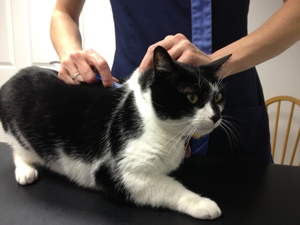A microchip is a small chip, the size of a grain of rice that is placed under the skin with a needle a little bigger than a vaccination needle. Microchips have a unique number which we will register to your personal contact details onto a national database. This means if your pet was ever lost and picked up by the police, the dog warden or taken to any vets, they can be scanned to obtain the microchip number and your details can be accessed by contacting the database. We routinely microchip dogs, cats and rabbits.
 Microchips can be placed in a normal consultation with either one of our veterinary surgeons or nurses. No sedation or local anaesthetic is required and we routinely microchip young puppies and kittens. We first use a handheld microchip scanner to scan your pet. This ensures that there has not already been a microchip placed (this is especially important if the history of your pet is unknown). We will then place the microchip between your pet’s shoulder blades and scan your pet to check it is in correctly.
Microchips can be placed in a normal consultation with either one of our veterinary surgeons or nurses. No sedation or local anaesthetic is required and we routinely microchip young puppies and kittens. We first use a handheld microchip scanner to scan your pet. This ensures that there has not already been a microchip placed (this is especially important if the history of your pet is unknown). We will then place the microchip between your pet’s shoulder blades and scan your pet to check it is in correctly.
The whole procedure takes only a couple of minutes. Occasionally microchips can migrate underneath the skin a little and, rarely, they will migrate further around the body. When scanning to see if a pet has a microchip the whole of the animal’s body is routinely scanned to ensure one is not missed if it has moved.
As of the 6th April 2016 it is a legal requirement to have your dog microchipped. Permanent identification of dogs in the UK will have many benefits. A microchip will help reunite lost dogs with their owners and will act to encourage responsible dog ownership. The introduction of this law is also aimed to help tackle puppy farming and help report hereditary health problems
Although it is not yet currently a requirement for cats or rabbits (unless your pet is travelling abroad) we would still strongly recommend getting them microchipped so we can return them to you safely if they do ever become lost.
